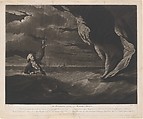The Perilous Situation of Major Mony, When He Fell into the Sea with His Balloon on the 23rd of July, 1785, Off the Coast of Yarmouth; Most Providentially Discovered and Taken Up by the Argus Sloop, After Having Remained in the Water During Five Hours
Engraver John Murphy Irish
After Philip Reinagle British
Not on view
This mezzotint depicts a dramatic incident of 1785, when Major Mony, a pioneering aeronaut, ascended in a hot-air balloon before 40,000 spectators in Norwich, a city northeast of London. A faulty valve prevented him from making a controlled landing and, after flying for nearly two hundred miles, he crashed just off the Isle of Wight, where he spent five hours in the water before being rescued. (The first manned balloon flight had taken place in France only two years before, and accidents, some fatal, were not uncommon.) Murphy, the engraver, who specialized in nighttime subjects, used the velvety qualities of mezzotint to enhance the drama of the scene. Here, the Major skillfully keeps himself afloat with his partially inflated balloon, while a small rowboat approaches in the background. The balloon lines crossing the picture plane accentuate the impression that the viewer is in the water alongside the protagonist.
This image cannot be enlarged, viewed at full screen, or downloaded.

